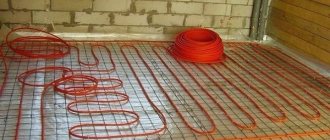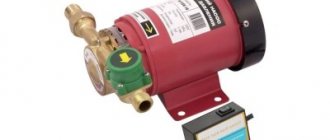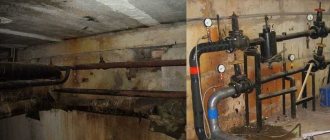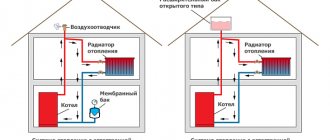What is water hammer in a pipeline, its causes
Water hammer is a sharp increase in pressure in systems transporting fluid, which occurs when there is a sharp change in the speed of fluid movement. A pressure surge can cause destruction of some elements of the system. Failures occur when the tensile strength of a connection or material is exceeded.
If we talk about our houses and apartments, water hammer occurs in heating and water supply systems. In heating systems of private houses - when starting or stopping the circulation pump. Yes, it does not create pressure by itself. But a sharp acceleration or stop of the coolant is the load that acts on the walls of the pipes and nearby devices. Closed heating systems have an expansion tank. It compensates for water hammer if the pump is nearby. In this case, additional devices may not be needed. You can check the need to install a compensator using a pressure gauge. If the needle does not move or moves barely noticeably, everything is fine.
The most common cause of water hammer is abruptly closing the tap.
In centralized heating systems, water hammer occurs when the damper is suddenly closed when the taps are quickly opened to fill the system after repair/prevention. According to the rules, this should be done slowly and gradually, but in practice it happens differently...
In water supply, water hammer occurs even when a tap or other shut-off valve is suddenly closed. More pronounced “effects” are obtained in air-filled systems. As water moves, it hits air pockets, which creates additional shock loads. We may hear clicking or crackling sounds. And if the water supply is routed with plastic pipes, during operation you can notice how these pipes shake. This is how they react to water hammer. You've probably noticed how the metal braided hose twitches. The reason is the same - pressure surges. Sooner or later, they will lead to either the pipe bursting at its weakest point, or the connection leaking (which is more likely and more common).
Water hammer can cause serious damage
Why was this phenomenon not noted before? Because now most taps have a ball valve and the flow closes/opens very abruptly. Previously, the taps were of the valve type and the valve was lowered slowly and gradually.
How to deal with water hammer in heating and water supply? You can, of course, train the inhabitants of an apartment or house not to turn on the taps sharply. But you can’t teach a washing machine or dishwasher to be careful with pipes. And the circulation pump cannot be slowed down during the start and stop process. Therefore, water hammer compensators are added to the heating or water supply system. They are also called dampers, shock absorbers.
Protection of pressure gauges from water hammer and high pressure
If an increased temperature of the environment leads to a gradual deterioration in the characteristics of the pressure gauge, then exposure to increased pressure, including short-term (water hammer) can instantly damage the pressure gauge.
The most common way to protect pressure gauges from small pressure surges is the use of curved siphon tubes (Perkins tubes), which also serve to cool the measured medium. Angled or straight Perkins tubes with a loop (an example of designation in the catalog of NPO "YUMAS" - selected pressure device OS100v, OS100-02, etc.) slightly dampen minor pressure fluctuations, for example, caused by the operation of pumping units, but do not protect against significant sudden pressure surges (water hammer). To protect pressure gauges from water hammer, special damping devices are designed.
Damping devices reduce pulsations of the measured medium and thus protect the measuring device from hydraulic shocks. The water hammer damper operates on a multi-chamber principle. Damping of water hammer is carried out by a so-called muffler. For example, the TTR damper has been shown to effectively damp pressure shocks lasting up to 20 ms. As the duration of the pressure pulse increases, the efficiency of the damper decreases.
Similar in purpose, Swagelok shock-absorbing fittings dampen pressure by using a porous sintered element made of 316 stainless steel. Installing a Swagelok shock-absorbing fitting (example designation SS-4-SA-EW) in front of the pressure gauge reduces the gauge's response rate. The response speed usually changes with the first drop in pressure in the porous element of the shock-absorbing fitting and allows the pressure gauge to gradually build up operating pressure.
An effective method of protecting measuring instruments from water hammer is to connect them to the process only when readings are taken, for example, using push-button valves. In the initial state, a push-button valve (for example, VE-2-2 NPO YUMAS) has a normally closed state - the pressure gauge is disconnected from the process and communicates with the atmosphere, which allows you to control the zero readings of the pressure gauge. When the operator presses a button on the valve, the pressure gauge is connected to the process and shows the current excess pressure in the system. When the button is released, the pressure gauge is automatically disconnected from the process again and “sits” to zero.
To reduce tremor (jittering) of the pressure gauge needle caused by minor pressure fluctuations, pressure gauges with glycerin or silicone filling are used. But it must be remembered that the use of pressure gauges with glycerin or silicone filling is not allowed in systems containing strong oxidizing agents. Surge dampers and shock-absorbing fittings should only be used to protect against sudden changes, impulses and pressure surges. Muffler damping devices and damping fittings require periodic maintenance and cleaning.
What is a water hammer compensator: types, design, principle of operation
There are two types of water hammer compensator: membrane and with a spring-loaded valve. They perform the same function: they accept excess liquid, thereby reducing the load on other elements of the system. Since these devices are small in size, they protect those devices that are located in close proximity.
The water hammer compensator is a small device, but it changes the picture significantly
How a membrane compensator works and works
A membrane water hammer compensator is a container that is divided into two parts by an elastic membrane. One of the parts is filled with air, the second is empty in its normal state. Air in the filled part is pumped under a certain pressure. To check/pump up pressure, there is a spool valve (nipple) in this part of the body. Products are supplied from the factory with an initial pressure of 3 bar. This is the “standard” value for most heating systems in single-story private houses. If the pressure needs to be changed, a pump is connected to the nipple and brought to the required value. This value is 20-30% higher than the working one in a particular system. But it should be significantly lower than the performance limit of the compensator itself.
Diaphragm shock absorber for hydraulic shocks in heating and water supply systems
As long as the pressure in the system does not exceed the pressure in that part of the tank, nothing happens. When a water hammer occurs, under the influence of increased pressure, the membrane stretches, part of the liquid enters the reservoir. As it normalizes, the elastic membrane tends to take its normal state, pushing the fluid back into the system. Thus, the jump is smoothed out.
Features of a spring water hammer damper
The second type of water hammer compensators works on the same principle: liquid is passed into the housing as the pressure increases. But access to the container is blocked by a plastic disk, which is supported by a spring. The pressure at which liquid begins to flow inside depends on the elastic force of the spring. It cannot be adjusted in any way (at least, no adjustable models have come across yet), so you have to select a device with suitable parameters.
Spring/disc type hydraulic shock compensator device
The operating principle of this damper is similar to that described above. While the pressure in the system is normal, the spring presses the disk against the body. When a water hammer occurs, it contracts and water enters the housing. As the pressure decreases, it becomes less than the elastic force of the spring. It gradually unclenches, returning the liquid to the pipeline.
The principle of water hammer compensation in a plumbing or heating system
As you can see, both devices work on a similar principle. Spring models are considered more reliable, since the working elements in them are less subject to wear (metal spring and durable plastic). But membranes are also made from materials that do not lose their elasticity for a long time. An additional plus is the ability to set the pressure at which the membrane begins to stretch. But the downside is the need to regularly check the pressure and, if necessary, pump it up.
Types of compensators
The choice of a protective element must be approached responsibly even at the preparation stages. Since heating networks are installed from different materials, different types of pipeline expansion joints are manufactured for them. In this case, you need to calculate the possible overload, and only then select an element with suitable parameters.
Omental
This type of fuse was one of the first to be used. And although the method is quite old, it continues to be used to this day. Because it guarantees smoothing out the increase in the dimensions of parts due to high temperature throughout the entire system, no matter how long it is. But such a compensator has a lot of disadvantages.
Disadvantages of stuffing box elements:
- Constant monitoring is required to detect leaks.
- They do not tolerate angular stresses well.
- Repairs are expensive and difficult to carry out.
- Not able to withstand chemical aggression.
Stuffing box compensator Source gryazeviky.ru
But even with such an abundance of shortcomings, stuffing box elements are positioned better than bellows pipeline compensators. And the whole point is that the smoothing ability of the former increases in proportion to the increase in network volume. The longer the pipeline is installed, the more reliable it works.
The steel structure includes two shells with different volumes. The smaller one is inserted into the larger one, and the connection is sealed with a special gasket. The stuffing box compensator can withstand pressure up to 2.5 MPa and an increase in ambient temperature up to +300 °C.
The inner tube can move inside the larger element, compensating for elongation and compression. And leaks are prevented thanks to a reliable seal. But due to the need to regularly tighten the hydraulic axle, the heating network must have an inspection well above each one.
Rubber
These fuses are the next most popular in use. Because they are universal and suitable for both steel structures and their polypropylene counterparts. Their fundamental difference is that the working element is a rubber insert.
Rubber expansion joint Source stblizko.ru
The advantages of rubber expansion joints include:
- Long service life (at least 20 years). Moreover, no repairs or maintenance are required throughout the entire period.
- More reliable resistance to cycle displacements relative to the original installation.
- Resistance to short-term axial deformations (tension and compression).
- The ability to wait out a vacuum.
- Resistance to aggressive chemical environments.
The working rubber element is placed between two steel flanges. The fuse also withstands system pressure up to 2.5 MPa. But the temperature increase should not exceed +200 °C. The protection began to be used to replace the U-shaped compensator, which was popular earlier, but did not always cope with the assigned tasks.
Where and how to install: installation recommendations
The water hammer compensator is small in size; only a small amount of water can fit into the housing (usually less than 200 ml). It is installed in close proximity to the source of water hammer: a ball valve, a water comb, on a hose to a washing machine or dishwasher, after a circulation pump, on a heated floor comb.
The water hammer compensator is installed close to consumers or on the comb
You can attach it in any position: up, down, to the side. For membrane models, it is only important that there is free access to the nipple. Regardless of the design, it is not recommended to install the device on long branches from the main line. The supply pipe section should be as short as possible.
Rules for installing a water hammer compensator
When choosing, pay attention to the maximum operating and compensated pressure. The second point is the connection diameter. Usually it is 1/2 inch, but there are also 3/4 and inch.
When connecting a washing machine and/or dishwasher, a tee is installed on the hose. One free outlet of the tee goes to the machine, and a water hammer compensator is installed on the second.
Other ways to combat water hammer
One of the possible options for neutralizing water hammer has already been voiced - close the taps smoothly. But this is not a panacea, and it is inconvenient in our fast-paced times. And there are also household appliances, you can’t teach them. Although, some manufacturers take this point into account, and the latest models are made with a valve that smoothly shuts off the water. This is why compensators and neutralizers are becoming so popular.
Water hammer compensator - a small device (comparison with a brass ball valve)
You can combat water hammer using other methods:
- When installing or reconstructing water supply or heating systems, insert a piece of elastic pipe in front of the source of water hammer. This is reinforced heat-resistant rubber or PPS plastic. The length of the elastic insert is 20-40 cm. The longer the pipe, the longer the insert.
- Purchase of household appliances and shut-off and control valves with smooth valve movement. If we talk about heating, problems with warm water floors are often observed. Not all servos operate smoothly when closing the flow. The solution is to install thermostats/thermostats with a smooth piston stroke.
- Use pumps with soft start and stop.
This is what water hammer protection devices look like in heating and water supply systems.
Water hammer is a really dangerous thing for a closed system. He breaks radiators and bursts pipes. To avoid problems, it is better to think through control measures in advance. If everything is already working, but problems arise, the smartest and easiest way is to install compensators. Yes, they are not cheap, but repairs will cost more.
What is water hammer and why is it feared?
Water hammer is a sudden and very strong surge in pressure in pipes. Capable of breaking connections and pipes themselves, tearing off valves and causing a flood. Small water hammers act gradually, over and over again squeezing out the gaskets, slowly but surely deforming and destroying water supply and heating pipes with microtraumas.
Externally, weak water hammer is recognized as vibration through the pipe, hum, popping, clicking or other extraneous sounds, which are especially annoying for residents whose neighbors get up earlier or go to bed later.
How does water hammer occur?
This is a phenomenon when in one section of the pipe the water has already stopped, and from behind it is pressed by masses that continue to flow:
- when the watercourse is suddenly blocked;
- when the pump starts abruptly.
In a heating system, water hammer is caused by air pockets.
Risk factors
What determines the force of water hammer:
- Depending on how abruptly the constipation or start of the watercourse occurred.
- The volume of water in the pipes and, accordingly, their size.
- The speed of fluid movement and its pressure.
- Pipe material.
Formula Shock wave frequency = 2 pipe lengths / shock propagation speed in a particular material.
Wave speed in plastic is 300-500 m/s. For comparison, in steel it is 900–1300, and in cast iron 1000–1200 m/s. It follows that in plastic the impact will be stronger, but cast iron liners actually dampen the water hammer.
What happens to the pipe?
Nothing good: it expands in breadth and shortens in length. Under pressure, the pipe may well burst. Faucets and connecting elbows suffer most often: seams come apart, gaskets move or break, and leaks begin.
From the memories of a mechanic I am in my third decade in the plumbing world, but I saw a real water hammer only once (1994) in an elevator unit <…>. Water hammer is when the <…> needle flies away in one second from 8 bar to 60.
The worst thing is water hammer in the elevator unit, at the pumping station and other general building communications. Pipes in apartments are subject to vibrations to a much lesser extent, but it is worth understanding that the cross-section of modern risers is narrower (the pressure is correspondingly higher) than that of Soviet steel ones, and the material is more mobile and less durable. First of all, hot risers pose a danger - materials expand more when heated.
Manufacturers, characteristics, prices
It is best to buy a water hammer compensator from well-known companies. This is not the area where it is appropriate to save money. The most popular are several companies:
- FAR. The compensator from this company is without a membrane, with a spring and a locking disc. Connecting thread 1/2″, maximum pressure 50 Bar, nominal pressure 10 Bar. Withstands temperatures up to 100°C. Price from 30 $.
- Uni Fitt. The same design with a spring-loaded disk. There are two body options: brass and nickel plated brass. Connection 1/2 inch. Maximum temperature 90°C, nominal pressure - 10 Bar, peak pressure - 20 Bar. The length of the protected pipeline is 10 m. Price from $15.
The same models are sold at different prices in different stores - Valtec (Valtek). This is a membrane type hydraulic shock absorber. There are models connected through a small ball valve with a pressure gauge. If necessary, open the ball valve and check the pressure in the compensator. The pressure in the chamber is 3.5 Bar, the maximum operating pressure is 10 Bar, the maximum compensated pressure is 20 Bar. Price from $25.
- CALEFFI (Caleffi). This company produces disk compensators. There are regular ones - with a 1/2″ connection, and there are 3/8″ ones for the sink. The parameters can be called good: the working pressure is no more than 10 Bar, they can compensate up to 40 Bar (for washing up to 30 Bar).
There are other companies, but they are not so popular. some due to being overpriced, others have not gained trust. At least for now.
Protection measures
To avoid ruptures, special devices are installed on all risers in basements, and in apartments on hot ones, which prevent vibrations from destroying the pipes.
We recommend: Proven methods for purifying vodka and alcohol at home
Locking devices, their pros and cons
Shock-absorbing lines are wave, loop or U-shaped pipes made of ordinary or special material, for example, reinforced plastic or rubber, 20-40 cm long, the simplest and cheapest option.
Shock-absorbing connections are cheap, and at the same time they can withstand the water hammer that plastic communications in an apartment have to experience in practice; they do not require special maintenance or periodic replacement of parts.
A bellows shock absorber is a corrugated pipe made of ductile metal that can compensate for linear expansion, elongation, or both phenomena at once; simpler ones are single-layer; more advanced ones are enclosed in a casing that provides additional shock absorption.
Bellows shock absorbers in a casing are also unpretentious, while being more aesthetically pleasing than the previous version.
Important: Shock absorbers (especially loop bends) and bellows are designed to compensate for the elongation of the riser; this is their main function, and the damping of water hammer is, rather, secondary. For plastic pipes, especially not of very high quality material, they are as important as expansion joints.
Shunts are metal tubes that are inserted into the pipe together through the main valve in the direction of water flow and bleed off the excess volume of water behind the valve; they are ineffective in old pipes clogged with rust; they are more suitable for plastic communications.
Shunts are easy to install and do not require opening the pipe, but they lose effectiveness in proportion to the clogging of the pipe, and in a domestic circuit this figure can be quite high.
Membrane compensators (the most common are Valtec) are devices that resemble a ball or tank and are a cavity with an elastic membrane, which is pressed in with a sharp increase in water pressure, and then gradually expands, returning the water to the current, but without impact force.
Diaphragm compensators hold up to 30 bar, and this is a pretty good indicator. Their weak point is an elastic membrane, which over time becomes deformed, breaks or hardens due to salts and additives in the water.
Piston, or spring (the most popular today - FAR) - devices similar to a cap and working on the same principle as membrane ones, with the difference that the membrane is replaced by a spring: with an increase in volume, water pushes a plastic disk into the cavity and thereby compresses spring, then the mechanism returns to its original position, returning water to the circuit.
Piston compensators can withstand surges of up to 50 bar and have ways to protect against real, not weak, water hammer. In addition, they are more resistant to wear than membrane ones, however, they are not immune to leaks at the seal or connection points with the pipe, so they need to be periodically checked and replaced.
Control valves are systems that are usually included in complex protection against water hammer and are installed on controllers of external and general house circuits.
We recommend: The hostess can serve the salad “like in a restaurant” - 3 step-by-step methods with photos
The bypass system is a jumper pipe that allows you to redirect the flow of coolant water in order to avoid water hammer and ruptures in the batteries.
Experts' opinion Old-school locksmiths consider the installation of indoor extinguishers to be a waste of effort and money. According to them, a strong water hammer threatens the water treatment channels in the basement, and that’s all. Other craftsmen note that in earlier times all taps were closed slowly, using a valve, but now they are mostly lever (ball) taps, and household appliances (washing machines, dishwashers) and toilet tanks also shut off the flow of water quite abruptly. Therefore, ideally, the damper should be located in front of each such consumer.
Comprehensive preventive measures:
- smooth closing of taps and valves;
- pump power regulator, which slows it down at the first revolutions and prevents it from provoking a shock wave.
Actually, water hammer absorbers have always included “coils” - a wave-like bend of a hot water riser, led into the bathroom from the toilet. Housewives used it as a heated towel rail. In essence, the pipe slowed down the flow of water and eliminated vibrations, reducing the risk of water hammer. However, leaks appeared quite often at the junction of the apartments, especially over the years.
Metal ages faster than high-quality plastic, the installation of ball valves significantly increased the load on the structure, and the difference in materials, when plastic was placed on top and metal was left below, or vice versa, makes itself felt. Because of this, the “coils” do not work.











